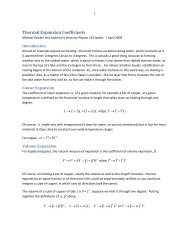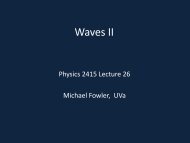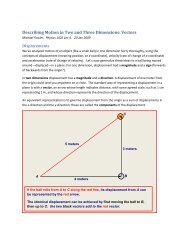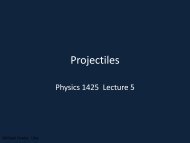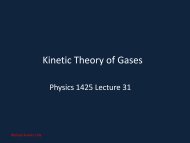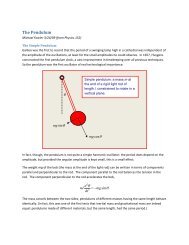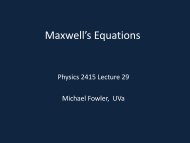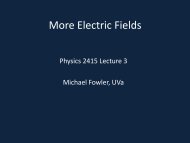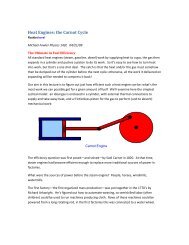Class Notes on Rotational Motion - Galileo and Einstein
Class Notes on Rotational Motion - Galileo and Einstein
Class Notes on Rotational Motion - Galileo and Einstein
Create successful ePaper yourself
Turn your PDF publications into a flip-book with our unique Google optimized e-Paper software.
10Then just do an integral to add up the moments of inertia of all the nested hoops from 0 to R to find themoment of inertia of the disk:R3 1 4 1 2disk 22I 2 r dr R MR .0The same expressi<strong>on</strong> works for a cylinder, which for these purposes is just a stack of disks.What about a rod about <strong>on</strong>e end? Assume its (c<strong>on</strong>stant) linear density is λ kg/m., so a length dx hasmass λdx. Then the moment of inertia isL2 3 2I x dx L / 3 ML / 3.0Suppose such a rod is hinged at <strong>on</strong>e end, horiz<strong>on</strong>tal, <strong>and</strong> falls. What is the initial accelerati<strong>on</strong> of its end?2 MgL / 2 I ( ML / 3) 3 gL / 2.So the end accelerates at Lα = 3g/2.If it is at first sight surprising that the end of the rod accelerates downwards faster then g, c<strong>on</strong>sider thefollowing system: a very light rod, hinged at <strong>on</strong>e end, with a large weight attached to its middle.A very light rod hinged to a wall at <strong>on</strong>e end has a mass atits center: how fast will the rod’s free end acceleratedownwards <strong>on</strong> release from a horiz<strong>on</strong>tal positi<strong>on</strong>?




